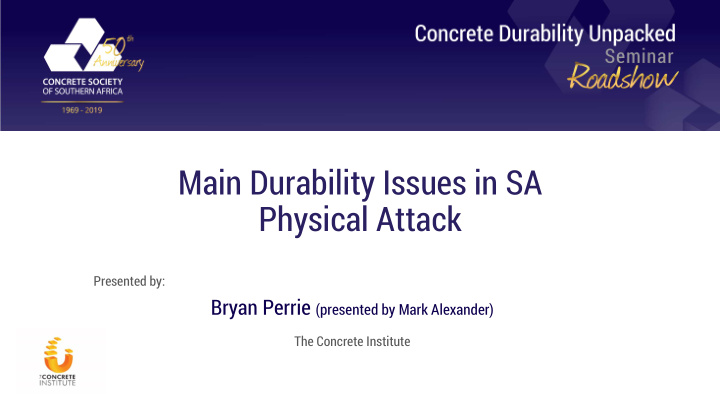



Main Durability Issues in SA Physical Attack Presented by: Bryan Perrie (presented by Mark Alexander) The Concrete Institute
Physical Attack • Abrasion • Traffic • Erosion • Freezing and freeze-thaw • Cavitation • Cracking • Temperature/moisture cycling • Abuse • Salt crystallisation • Fire
Abrasion Wearing of the surface due to repeated rubbing or friction • Largely governed by aggregate quality but combination with paste quality • Improve by finishing, curing
Erosion Wearing of surface by abrasive action of fluids, suspended solids and wind borne sand Special case of Abrasion • Improve by removing abrasive material, reducing flow and wind speed
Cavitation Change in velocity or direction of high velocity flow • Improve by design to reduce velocity and direction of flow
Temperature and moisture cycling Can cause crazing and surface degradation
Salt crystallisation Wetting and drying in marine environments allows soluble salts ingressing in the wet cycle, to crystallise in the dry cycles resulting in expansive pressures and spalling • Reduce permeability
Fire Concrete strengths reduce with increasing temperature above 300º C The strength reduction is roughly linear up to 1000º C when it has lost all strength Reinforcing steel strength also reduces (also the yield) Often accompanied by spalling Most damage done by fire brigade
Traffic Traffic results in fatigue and cracking and also loss of texture in roads, runways and industrial pavements • Increase flexural and compressive strength with good curing
Freezing and freeze-thaw Freezing is expansive and disruptive Freeze-thaw results in: • D-cracking adjacent to joints • Delamination and scaling • Aggravated by de-icing salts
Freezing and freeze-thaw (cont.) Factors include: • Porosity/permeability • Aggregate characteristics • Moisture state • Climatic conditions
Cracking Includes: • Plastic shrinkage • Drying shrinkage • Thermal • Overstressing • Deflections
Abuse • Lack of housekeeping • Overloading • Lack of maintenance including joint seals
Physical Attack • Abrasion (Concr, Const, HC?) • Traffic (Des, Concr, Const) • Erosion (Des, Concr, Const, HC) • Freezing and freeze/thaw (Des, • Cavitation (Des) Concr, Const) • Temperature/moisture cycling (Des, • Cracking (Des, Const) Concr) • Abuse (HC) • Salt crystallisation (Concr, Const) • Fire (HC)
Thank You
Recommend
More recommend